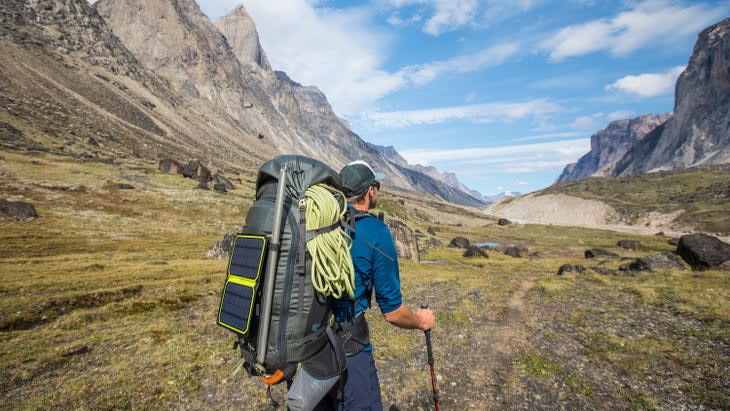Do Your Fingers Swell When You Hike? Here’s Why—and How to Fix It.
This article originally appeared on Backpacker
I have chronic circulation problems--it doesn't take much for my extremities to turn purple and feel icy--so I am always on the defensive when it comes to exercise-related hand and foot care. While hiking, my digits sometimes swell and feel stiff, resembling "sausage fingers." There is not one clear-cut cause for this phenomenon; swollen hands and fingers are your body's response to the physical stressors that come with hiking. Here are some of the reasons why they could become stiff and swollen on the trail, with tips on how to fix them.
Video loading...
Blood vessel expansion
On the trail, your blood primarily flows to your heart, lungs, and leg muscles, which means your hands don't get as much blood flow as normal. This can result in swollen fingers as your blood vessels open wide to let as much blood through as possible.
The fix: While hiking, pay attention and try to notice if you are doing anything to restrict blood flow to your hands, such as keeping your fists clenched for prolonged periods of time or hunching your back. According to Dr. Edward Laskowski--a skier, hiker, cyclist, climber and co-director of the Mayo Clinic Sports Medicine Center--there are a couple things you can do to ease symptoms of swollen hands as they occur:
Remove tight jewelry (rings, bracelets, etc.) and loosen your watchband before hiking. If you forgot, you can use sunscreen or lip balm to help rings slide over swollen fingers. Or, save yourself the trouble and opt for these swell-proof silicon rings.
Rotate your arm in large forward and backward circles while you walk.
Stretch your fingers and make fists several times throughout the hike to promote circulation.

Tight backpack straps
Blood carries oxygen from your heart and throughout your body, but anything that gets in the way of this flow can lead to blood pooling in the hands. A too-tight backpack strap prevents blood from making it past your shoulder to the rest of your body. Think of it as when you crimp or step on a hose; it blocks the regular flow of the water. This fluid imbalance leads to peripheral edema: the swelling of your lower legs and hands because something interrupted the regular flow of fluids in your body.
The fix: No need to stress. Your hands will start shrinking down to normal once you finish hiking. But there are a few things you can do to prevent the swelling int he first place. Before you hit the trails, learn how to pack your backpack and wear it correctly. For overnight hikes, it shouldn't be more than 20 percent of your body weight, and for dayhikes, keep it below 10 percent. Use your hipbelt to distribute pack weight evenly instead of putting all the pressure on your shoulders and chest. If you are unsure about weight distribution or pack fit, go to your nearest outdoor retailer and get your backpack fitted for you.
Next, pull out your trekking poles. They help prevent swelling because they keep your arms moving and promote better circulation throughout the whole body. Keeping your arms dangling at your sides while you ascend inhibits circulation. If your pack is heavy, using poles helps shift the weight off your shoulders with each step.

Hyponatremia
Sometimes, endurance athletes such as thru-hikers and marathon runners, accidentally dilute their body's sodium levels when they drink too much water without supplementing with salt. Low sodium levels mean your body's water levels rise, and your cells expand. Swelling is one symptom, but it’s not the most important or dangerous, as hyponatremia causes nausea, headache, confusion, and fatigue. This one’s serious: If you feel nauseated, confused, or unreasonably tired, seek medical attention immediately.
The fix: This depends on the severity of the condition. In mild cases, you should cut back on your fluid intake. Christopher Tedeschi, associate professor of emergency medicine at Columbia University and Backpacker columnist, says there's no one-size-fits-all solution to hydration, but there are some universal ground rules everyone should follow: "Instead of slugging down as much water as you can, use common sense. Drink if you're thirsty. Salty snacks help along the way if you're drinking loads of water on sweltering days." If you have nausea, headaches, brain fog, or muscle cramping while hiking, you might need to get out of the backcountry for an electrolyte IV or specific medication.
Menstrual hormones
If dealing with your period wasn’t fun enough, your rapidly shifting hormones during PMS could also make your fingers and hands swell. Water retention is a common symptom that people manage in the days leading up to the period itself.
The fix: Track how you feel throughout your entire menstrual cycle. If you report swollen hands and fingers at home, take precautions if you’re hitting the trails during PMS or around the time in your cycle those symptoms arise.
Last updated May 2023
For exclusive access to all of our fitness, gear, adventure, and travel stories, plus discounts on trips, events, and gear, sign up for Outside+ today.

